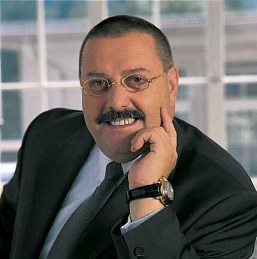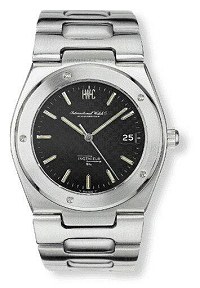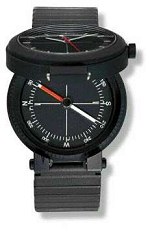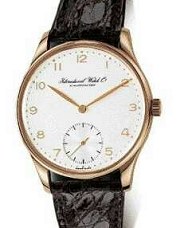TimeZone Interview with Hannes Pantli February 2002

Hannes Pantli has been an icon of International Watch Company, as well as the entire Swiss watch industry, for close to 30 years. He started with IWC before the quartz dark ages, when the company was still owned by the Homberger family, and he has witnessed many changes over the years. Mr. Pantli is about to retire as Executive Vice President of IWC, although he will continue on the Board.
In this interview, Mr. Pantli describes the development of a major Swiss watch company over the past three decades. After recounting a historical legacy through his career, he shares specific insights about the current direction of the company. Mr. Pantli strongly believes in the vitality of IWC’s future.
|
MF: Michael Friedberg – TimeZone.com HP: Hannes Pantli |
MF: Mr. Pantli, when did you start working for IWC?
HP: I started in 1972 with responsibility for European sales.
MF: Didn’t you start just as the quartz disaster was beginning?
HP: Actually, IWC launched its first quartz watch in1969. However, no one took it seriously and people asked, “who needs this accuracy at an extremely high price?” The quartz resonator was extremely fragile and cost CHF 350 to replace.
In 1973, the year after I started, IWC was doing extremely well and had its largest production up to that time, with 54,000 pieces. It was not until the Spring of 1974 when the industry was really hurt. This was due not only to the introduction of inexpensive quartz movements, but also the Bretton-Woods Act, which eliminated fixed exchange rates, as well as the price of gold no longer being fixed. The Swiss franc and gold prices rose dramatically.
MF: Were you worried? What happened then?
HP: Worried? Not really. I was a bachelor then and didn’t mind the risk.
However, in two years the company went from 350 employees to 145. The sales manager left and the marketing manager was fired. I received an offer from the Homberger family to be in charge of marketing.
By 1976, we couldn’t sell watches. We had 10,000 watches in Hong Kong that became unsellable. I had to look for new markets.
MF: What saved the company?
HP: New markets helped, and the Persian Gulf became important. Also, jewelry watches for men and women were beginning to sell at an incredible rate.
 MF: But wasn’t IWC planning to introduce a new Ingenieur and other mechanical watches during this period?
MF: But wasn’t IWC planning to introduce a new Ingenieur and other mechanical watches during this period?HP: We generally believed that the market was not sophisticated enough for mechanical watches. In 1974 and 1975, we worked with Gerald Genta, who designed the Reference 1832, the jumbo Ingenieur, and also the Polo and Golf Club models. However, the important turnover came from jewelry watches. I think that the Ingenieur was ahead of its time. That was the problem. None of these mechanical watches, not even the new Ingenieur, was successful.
MF: Would jewelry watches really have saved IWC in the ‘70s?
HP: People then were considering what might occur if mechanical watches came to a complete end. There was an idea in 1976 to reduce the factory to 40 or 50 employees. They would produce only complicated watches – mainly pocket watches.
In fact, I visited the Lange family in 1976, and we talked about cooperation in the pocket watch field but did not reach a conclusion. Back then, we believed that pocket watches were the only way to save the mechanical watch.
MF: I’ve noticed that, in the late 70s and early 80s, IWC produced many interesting pocket watches. Did that save the company?
HP: No. We decided that the clientele for pocket watches was getting too old. We needed to look at the “junior executive” level for customers.
 What changed the company was our cooperation with Porsche Design. The introduction of models like the compass watch, the Ocean 2000 and the titanium chronograph –where titanium was used for the first time -- opened a new market.
What changed the company was our cooperation with Porsche Design. The introduction of models like the compass watch, the Ocean 2000 and the titanium chronograph –where titanium was used for the first time -- opened a new market.MF: The cooperation with Porsche Design started before Günter Blümlein joined IWC?
HP: Yes. It was two years before Mr. Blümlein joined. In 1977, the Homberger family was not willing to invest more money, so we had to look for other partners. We discussed possible partnerships with 17 Swiss companies, but back in 1977 the Swiss watch industry was considered a bad investment. Finally, our own bank, then called Swiss Bank Corporation, put us in contact with VDO. That company made instruments in Germany.
The CEO of VDO then was a Mr. Keck, who was a watchmaker in his younger days. He spent a half-day touring the factory and then said, “Okay, we’ll buy it”. It was not a logical decision.
MF: What plans did VDO have for IWC?
HP: They had a plan that didn’t work out. The idea was that there would be a combination between the French watchmaking companies, which were owned by Matra, German watchmaking companies owned by VDO, and three Swiss watchmaking companies. The Swiss companies were IWC and the Sapphire Group (JLC and Favre-Leuba).
VDO was looking for a position for Mr. Blümlein, who previously advised them regarding this proposed European Watch Group. He became CEO of IWC in 1980, and he was an outstanding person. Although not a watchmaker, he was a great technician. He knew everything. He previously was in charge of production at Junghans and also was extraordinarily good in marketing. He had the strength to target an end and proceed without looking left or right.
Mr. Blümlein expanded the cooperation with Porsche, which was one of the decisions that guaranteed the survival of IWC. However, the Board at that time wanted no more than one-third of the company’s turnover to be Porsche Design, although sales never reached that percentage.
MF: IWC’s sales then really expanded in the 1980s and ‘90s, didn’t they?
HP: Mr. Klaus designed the new DaVinci with Mr. Blümlein’s encouragement. But it was not a success at first. By the way, it really was introduced in 1986, not 1985 as everyone thinks. I’ve looked at all the Basel catalogs.

The 90s were very strong and I believe influenced by the Portugieser. This was a very calculated product, because we wanted to develop a limited edition for our 125th anniversary that reflected IWC’s tradition. With the Portugieser, we believe that we are the company that re-launched big watches. Also credit has to be given to the Flieger models, which we have built since 1935 and which involved several interesting new models through 1998.
MF: You were with IWC when the Homberger family owned it in the 1970s, and then VDO, which subsequently evolved to Mannesman, in the ‘80s and 90s. What is it like now to have Richemont as a parent?
HP: Well, we were dreaming of a small group of investors who would have zero to do with the watch industry. I think the old shareholders spoiled us, but realistically the only two purchasers were either the Swatch Group or Richemont. We never seriously considered LVMH as a contender.
I believe that Richemont’s acquisition was a very good decision. We belong in their luxury group, as the engineers of that group. It is a very complementary relationship.
MF: But I have heard rumors about a need to increase production by huge amounts in order to make the acquisition profitable. Is that true?
HP: Not at all. Richemont was buying know-how for the long term, which otherwise would have taken billions and many years. Richemont has never mentioned any such sales figures, although I expect turnover – but not volume – will increase. I can foresee a day when IWC might produce 70,000 or 80,000 watches.
The economy right now is not in a time of large growth, so we are in a position to develop slowly. Also, the current management is intelligent: Mr. Kern, the new CEO, understands exactly the strength of IWC. The company always will be engineers of the watch trade and will always produce special pieces.
MF: What changes are currently going on at IWC?
HP: Even in a few weeks, Mr. Kern has made a difference. He really understands the product, and he is extremely fond of watches. We need ideas for new products and we have two new designers coming on board.
Also, I think I can say that we are at least exploring today a new Ingenieur. I am not sure yet whether it will be a mono-product or a line. We are talking to a very famous designer about the project, although nothing is definite and no arrangements have been confirmed. But we have had discussions.
We are now much more active regarding the product line. We might need to freshen up the GST models. We might need a replacement for the Destriero. Mr. Kern is really behind changes and this is a major activity of his. As a result, I am very optimistic about the future.
MF: What else is Mr. Kern doing beyond enhancing the product line?
HP: He is working with retailers. He just met with Mr. Huber from Munich and visited Mr. Wempe. I introduced him to the people at the Swiss stores, including Türler, Bucherer, Beyer, Les Ambassadeurs, etc. All of these meetings went perfectly, because Mr. Kern can talk product and has clear visions.
MF: Do you expect IWC to expand? Some people are saying that the “boom times” of the 90s are over and that the market has peaked.
HP: Not for IWC. I don’t think so because we haven’t introduced many new models over the last four years. I believe that there is a real hunger for retailers and fans for new IWC products.
In some markets, like the United States, we have made important steps, but still brand awareness is small in these markets. I am convinced that Richemont can help us a lot in these markets
MF: What about you personally? What are you going to be doing upon your retirement?
HP: Originally, I was going to take some time off, but I don’t know now. Richemont has convinced me to serve as a management consultant.
I also will be involved with our magazine WATCH INTERNATIONAL and starting a new IWC museum. And remember the around-the-world trip by the JU-52 airplane that didn’t work in 2001? We are going to be doing a new one in 2003 and, hopefully, fly around the world.
Finally, I will be on the Supervisory Board for IWC for the years to come.
MF: A Board membership? Could you explain who is on the Board and how that works? I understand there’s a lot of continuity.
HP: The Swiss corporate system knows two Boards. The first is the “Supervisory Board” for IWC and it will have three members. There is Mr. Belmont, who is Mr. Blümlein’s successor and head of the watch group at Richemont. There’s also Mr. Dellenbach, who formerly was the chief financial officer of the LMH Group and now has been named the Chief Operating Officer of IWC and Lange. The third member of the IWC Supervisory Board will be me.
Mr. Kern as CEO will head the “Management Board”. The others are all people who are or have been with IWC, including Mr. Jäger, who is responsible for production, and Mr. Eisenegger, the technical director. There’s also Mr. Hugelshofer, logistics, and last but not least Mr. Meier as CFO. And, this isn’t official yet, but Marc Bernhardt will be on the Board. As you know, Mr. Bernhardt will be heading global sales and leaving his position in the United States.
MF: It seems like your position on the Supervisory Board, as well being involved in product and other activities will certainly keep you busy. As a last subject, could you tell us a little bit about your collection? I once heard a rumor that you have two of every model.
HP: (Laughs) I have had a good collection, but not two of every model. Recently, Richemont asked me to sell most of my watches to them permanently for the new museum. I still have a few good pieces.
I have one of only two of the “La Magique” pocket watches that were convertible or what you call a Cabriolet. I purchased that from a noble family in Palermo. No one knows where the other one is.
I also have a watch with the Calibre 1000, which was to be the new ultra-thin automatic watch planned for the 100th anniversary of IWC in 1968. Every technical director since then has wanted to resurrect the Calibre 1000, but no one has been able to do it successfully.
 I also had five complete sets of the flight watches. IWC needs them for exhibits that travel. But I only have two of the old Portugiesers: one with a black dial and one with a white dial, from the first series. They are very hard to find.
I also had five complete sets of the flight watches. IWC needs them for exhibits that travel. But I only have two of the old Portugiesers: one with a black dial and one with a white dial, from the first series. They are very hard to find.When the Homberger family sold the company in the late 1970s, as an expression of appreciation they allowed the three members of the Board of Directors to buy one watch at cost. We all bought a pocket watch, namely Reference 5450. At the moment I believe that pocket watches are under-valued but they will come back. In my view, good pocket watches are better investments than the average stock exchange investment. In the long run they are better, and I can prove that.
MF: Mr. Pantli, thank you very much. Your historical information and insights regarding what is going on currently are very much appreciated. I suspect that your retirement will be anything but inactive.
Michael Friedberg
Past Time
All Rights Reserved